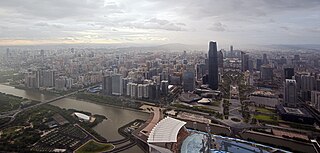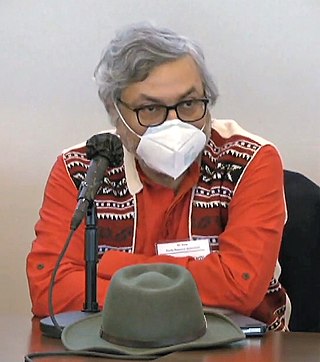
A city is a human settlement of a notable size. It can be defined as a permanent and densely settled place with administratively defined boundaries whose members work primarily on non-agricultural tasks. Cities generally have extensive systems for housing, transportation, sanitation, utilities, land use, production of goods, and communication. Their density facilitates interaction between people, government organizations, and businesses, sometimes benefiting different parties in the process, such as improving the efficiency of goods and service distribution.

Urbanization is the population shift from rural to urban areas, the corresponding decrease in the proportion of people living in rural areas, and the ways in which societies adapt to this change. It can also mean population growth in urban areas instead of rural ones. It is predominantly the process by which towns and cities are formed and become larger as more people begin living and working in central areas.

Urban ecology is the scientific study of the relation of living organisms with each other and their surroundings in an urban environment. An urban environment refers to environments dominated by high-density residential and commercial buildings, paved surfaces, and other urban-related factors that create a unique landscape. The goal of urban ecology is to achieve a balance between human culture and the natural environment.

Urban geography is the subdiscipline of geography that derives from a study of cities and urban processes. Urban geographers and urbanists examine various aspects of urban life and the built environment. Scholars, activists, and the public have participated in, studied, and critiqued flows of economic and natural resources, human and non-human bodies, patterns of development and infrastructure, political and institutional activities, governance, decay and renewal, and notions of socio-spatial inclusions, exclusions, and everyday life. Urban geography includes different other fields in geography such as the physical, social, and economic aspects of urban geography. The physical geography of urban environments is essential to understand why a town is placed in a specific area, and how the conditions in the environment play an important role with regards to whether or not the city successfully develops. Social geography examines societal and cultural values, diversity, and other conditions that relate to people in the cities. Economic geography is important to examine the economic and job flow within the urban population. These various aspects involved in studying urban geography are necessary to better understand the layout and planning involved in the development of urban environments worldwide.

Trifolium repens, the white clover, is a herbaceous perennial plant in the bean family Fabaceae. It is native to Europe, including the British Isles, and central Asia and is one of the most widely cultivated types of clover. It has been widely introduced worldwide as a forage crop, and is now also common in most grassy areas of North America, Australia and New Zealand. The species includes varieties often classed as small, intermediate and large, according to height, which reflects petiole length. The term 'white clover' is applied to the species in general, 'Dutch clover' is often applied to intermediate varieties, and 'ladino clover' is applied to large varieties.

The white-footed mouse is a rodent native to North America from Ontario, Quebec, Labrador, and the Maritime Provinces to the southwestern United States and Mexico. In the Maritimes, its only location is a disjunct population in southern Nova Scotia. It is also known as the woodmouse, particularly in Texas.
Ecology and evolutionary biology is an interdisciplinary field of study concerning interactions between organisms and their ever-changing environment, including perspectives from both evolutionary biology and ecology. This field of study includes topics such as the way organisms respond and evolve, as well as the relationships among animals, plants, and micro-organisms, when their habitats change. Ecology and evolutionary biology is a broad field of study that covers various ranges of ages and scales, which can also help us to comprehend human impacts on the global ecosystem and find measures to achieve more sustainable development.

The University of Toronto Mississauga (UTM), also known as U of T Mississauga, is one of the three campuses that make up the tri-campus system of the University of Toronto. Located in Mississauga, Ontario, Canada, the campus opened in 1967 as Erindale College, set upon the valley of the Credit River, approximately 33 km west of Downtown Toronto. It is the second-largest of the three University of Toronto campuses, the other two of which are the St. George campus in Downtown Toronto and the U of T Scarborough campus in Scarborough, Ontario.

In ecology, urban ecosystems are considered a ecosystem functional group within the intensive land-use biome. They are structurally complex ecosystems with highly heterogeneous and dynamic spatial structure that is created and maintained by humans. They include cities, smaller settlements and industrial areas, that are made up of diverse patch types. Urban ecosystems rely on large subsidies of imported water, nutrients, food and other resources. Compared to other natural and artificial ecosystems human population density is high, and their interaction with the different patch types produces emergent properties and complex feedbacks among ecosystem components.

The medium ground finch is a species of bird in the family Thraupidae. It is endemic to the Galapagos Islands. Its primary natural habitat is tropical shrubland. One of Darwin's finches, the species was the first which scientists have observed evolving in real-time.

Urbanization in China increased in speed following the initiation of the reform and opening policy. As of 2022, China had an urbanization rate of 64.7% and is expected to reach 75-80% by 2035.

Urban wildlife is wildlife that can live or thrive in urban/suburban environments or around densely populated human settlements such as townships.
Urban science is an interdisciplinary field that studies diverse urban issues and problems. Based on research findings of various disciplines such as history, economics, sociology, administration, architecture, urban engineering, transportation engineering, landscape architecture, environmental engineering, and geo-informatics, it aims to produce both theoretical and practical knowledge that contributes to understanding and solving the problems of urban issues in contemporary society.

The University of Toronto Mississauga is a satellite campus of the University of Toronto. It is in Mississauga, Ontario, Canada about 33 kilometres west of the main St. George campus. It was formerly called the Erindale College but was later changed to the University of Toronto Mississauga (UTM). The campus has eight main educational buildings: the Maanjiwe nendamowinan Building, Deerfield Hall, the William G. Davis Building, the Kaneff Centre and Blackwood Gallery, the Recreation, Athletic, and Wellness Centre, the Hazel McCallion Academic Learning Centre which holds UTM's library, the Instructional Building, and the new Terrence Donnelly Health Sciences Complex for the Mississauga Academy of Medicine. The campus also houses 3 residence halls: Erindale Hall, Roy Ivor Hall, and Oscar Peterson Hall.
Urban evolution refers to the heritable genetic changes of populations in response to urban development and anthropogenic activities in urban areas. Urban evolution can be caused by mutation, genetic drift, gene flow, or evolution by natural selection. Biologists have observed evolutionary change in numerous species compared to their rural counterparts on a relatively short timescale.

Climate change and cities are deeply connected. Cities are one of the greatest contributors and likely best opportunities for addressing climate change. Cities are also one of the most vulnerable parts of the human society to the effects of climate change, and likely one of the most important solutions for reducing the environmental impact of humans. More than half of the world's population is in cities, consuming a large portion of food and goods produced outside of cities. The increase of urban population growth is one of the main factors in air-quality problems. In the year 2016, 31 mega-cities reported having at least 10 million in their population, 8 of which surpassed 20 million people. However, secondary cities - small to medium size cities are rapidly increasing in number and are some of the fastest growing urbanizing areas in the world further contributing to climate change impacts. The UN projects that 68% of the world population will live in urban areas by 2050. Hence, cities have a significant influence on construction and transportation—two of the key contributors to global warming emissions. Moreover, because of processes that create climate conflict and climate refugees, city areas are expected to grow during the next several decades, stressing infrastructure and concentrating more impoverished peoples in cities.
Xuemei Bai (白雪梅) is a professor for Urban Environment and Human Ecology at the Australian National University. She was the winner of the 2018 Volvo Environmental Prize, and is an elected fellow of the Academy of the Social Sciences in Australia.
The Rural-Urban gradient is a gradient that is used to describe how Anthropocene effects affect their surroundings and how they compare to areas less affected by Anthropocene effects. Effects such as but, not limited to disturbance, change in biota, pollution, and landscape modification. Mainly used in the context of ecosystem services, it has also been used to describe biodiversity along the gradient, as well as behavioral change.

Madhusudan Katti is an Indian American environmental scientist who is an Associate Professor of Ecology at the North Carolina State University. His research studies the evolutionary ecology of vertebrate response to human modifications of habitats.
Marc Johnson is a professor of biology at the University of Toronto Mississauga. He is the Canada Research Chair for Urban Environmental Science, and was the first Director of the Centre for Urban Environments from 2018-2023.












